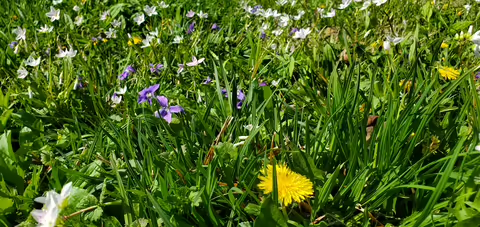Greening spring lawns are a welcome sign to many of us, but they are also a sign of yardwork to come for the rest of the growing season. The desire to get a jump start on mowing for season, or perhaps to get outside and be active after winter dormancy, spurs a lot of early season grass cutting. However, there may be good reason to slack off a bit this spring.
One of those reasons relates to a common turfgrass inhabitant, the dandelion (Taraxacum officinale). While this plant is often the bane of many homeowner’s existence, it offers a bit of diversity and ecological value in otherwise devoid greenspace of lawn.
Dandelions are native to Eurasia but were introduced on this continent long ago. They were brought here for their culinary value and ease of cultivation, with nearly all parts of the plant being edible. Flowers have been used for a variety of dishes and wines, while foliage can be incorporated in salads or other dishes as fresh greens. The leaves are actually high in vitamins and minerals although they quickly become bitter as flowerheads develop, so be sure to harvest your greens early.
As a word of caution, its important to be sure any dandelions you harvest have not been exposed to harmful substances, such as pesticides. Additionally, stems and roots of dandelion contain latex, which may cause an allergic reaction.
From an ecological perspective, dandelions are widely used by native wildlife. Pollinating insects feed from its flowers and foliage supports larvae of many moth species. In total, over 50 insects have been noted to use dandelions at some stage of their lifecycle, from moths and butterflies to grasshoppers and beetles. Some songbirds eat leaves, blooms or seeds and half a dozen native mammals consume some part of the plant. Even reptiles make use of dandelions with two species of native box turtles noted to feed on foliage.
Perhaps the most important aspect of dandelions as wildlife forage is the timing of their blooms. Since they emerge early in spring and are often productive late in the season, they can be a valuable pollinator food. As a member of the aster family, they have the distinctive composite flower structure associated with Asteraceae, often housing up to 200 individual flowers in single tiny yellow flowerhead.
A tiny, native flower can often be found blooming across spring lawns as dandelions show their bright yellow blooms. The contrasting purple color of violets (Viola sororia) is often present for a month or longer, although these blooms are less attractive to pollinating insects than the hundreds of open florets on a single dandelion bloom.
Species in the genus Viola are known for an amazing adaptation that bypasses the insect pollination process. Later in summer, a second type of flower emerges to produces seeds through self-pollination. These inconspicuous flower structures are known as cleistogamous flowers, which are flowers that don’t open. They don’t even produce petals and occur low on the plant, near the soil line. The interesting, minute structures produce seeds with a fatty appendage that attracts ants. As unwitting ants collect the seeds to feed upon this appendage, they serve as one of the primary sources of seed dispersal.
Perhaps the greatest value to pollinations from violets lies in their foliage, which serves as an important food source for a number of butterfly caterpillars. However, the spring blooms do attract some bees, syrphid flies and other insects.
This spring consider taking a break from mowing and allow some diversity to flourish in your lawn. Although many would view these plants as weeds, turfgrass alone offers little to no value to pollinators and other wildlife. We’ve all been trained to recognize monotypic stands of grass as the ideal plant community, representing a well-maintained property, but I find a diversity of flora and fauna much more interesting.
